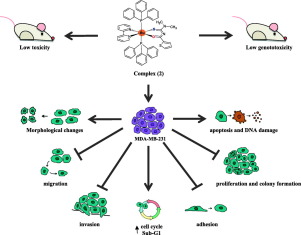Journal of Inorganic Biochemistry ( IF 3.9 ) Pub Date : 2018-05-24 , DOI: 10.1016/j.jinorgbio.2018.05.011 Amanda Blanque Becceneri , Cecília Patrícia Popolin , Ana Maria Plutin , Edson Luis Maistro , Eduardo Ernesto Castellano , Alzir Azevedo Batista , Márcia Regina Cominetti

|
Triple negative breast cancer (TNBC) is a heterogeneous subtype of breast tumors that does not exhibit the expression of estrogen and progesterone receptors, neither the amplification of the human epidermal growth factor receptor 2 (HER-2) gene. Despite all the advances in cancer treatments, the development of new anticancer drugs for TNBC tumors is still a challenge. There is an increasing interest in new agents to be used in cancer treatment. Ruthenium is a metal that has unique characteristics and important in vivo and in vitro results achieved for cancer treatment. Thus, in this work, with the aim to develop anticancer drugs, three new ruthenium complexes containing acylthiourea ligands have been synthesized and characterized: trans-[Ru(PPh3)2(N,N-dibutyl-N′-benzoylthioureato-k2O,S)(2,2′-bipyridine (bipy))]PF6 (1), trans-[Ru(PPh3)2(N,N-dimethyl-N′-thiophenylthioureato-k2O,S)(bipy)]PF6 (2) and trans-[Ru(PPh3)2(N,N-dimethyl-N′-benzoylthioureato-k2O,S)(bipy)]PF6 (3). Then, the cytotoxicity of these three new ruthenium complexes was investigated in TNBC MDA-MB-231 and in non-tumor MCF-10A cells. Complex (2) was the most selective complex and was chosen for further studies to verify its effects on cell morphology, adhesion, migration, invasion, induction of apoptosis and DNA damage in vitro, as well as its toxicity and capacity of causing DNA damage in vivo. Complex (2) inhibited proliferation, migration, invasion, adhesion, changed morphology and induced apoptosis, DNA damage and nuclear fragmentation of TNBC cells at lower concentrations compared to non-tumor MCF-10A cells, suggesting an effective action for this complex on tumor cells. Finally, complex (2) did not induce toxicity or caused DNA damage in vivo when low doses were administered to mice.
中文翻译:

的反式- [茹(PPH 3)2(Ñ,Ñ二甲基Ñ '-thiophenylthioureato-K 2 O,S)(联吡啶)] PF 6复合物具有对三阴性乳腺癌细胞和呈现低毒性促凋亡作用体内
三阴性乳腺癌(TNBC)是乳腺肿瘤的异质亚型,既不表现出雌激素和孕激素受体的表达,也不表现出人类表皮生长因子受体2(HER-2)基因的扩增。尽管癌症治疗取得了所有进展,但针对TNBC肿瘤的新型抗癌药物的开发仍然是一个挑战。人们对在癌症治疗中使用的新药物越来越感兴趣。钌是一种金属,具有独特的特性,并且在体内和体外的癌症治疗结果中均具有重要意义。因此,在这项工作中,以开发抗癌药物为目标,合成并表征了三种新的含酰基硫脲配体的钌配合物:反式-[Ru(PPh 3)2(N,N-二丁基-N'-苯甲酰基硫脲-k 2 O,S)(2,2'-联吡啶(bipy))] PF 6 (1),反式-[Ru(PPh 3)2(N,N-二甲基-N'-硫代苯基硫脲-k 2 O,S)(bipy)] PF 6 (2)和反式-[Ru(PPh 3)2(N,N-二甲基-N'-苯甲酰基硫脲-k 2 O, S)(bipy)] PF 6 (3)。然后,在TNBC MDA-MB-231和非肿瘤MCF-10A细胞中研究了这三种新的钌配合物的细胞毒性。复(2)是最有选择性的复杂和被选择用于进一步的研究,以验证其对细胞形态,粘附,迁移,侵入,细胞凋亡和DNA损伤的感应效应在体外,以及它的毒性和导致DNA损伤的能力在体内。与非肿瘤MCF-10A细胞相比,低浓度的复合物(2)抑制TNBC细胞的增殖,迁移,侵袭,粘附,改变形态并诱导凋亡,DNA损伤和核碎裂,表明该复合物对肿瘤细胞具有有效作用。最后,复杂(2)当对小鼠低剂量给药时,它不会在体内诱导毒性或引起DNA损伤。


























 京公网安备 11010802027423号
京公网安备 11010802027423号